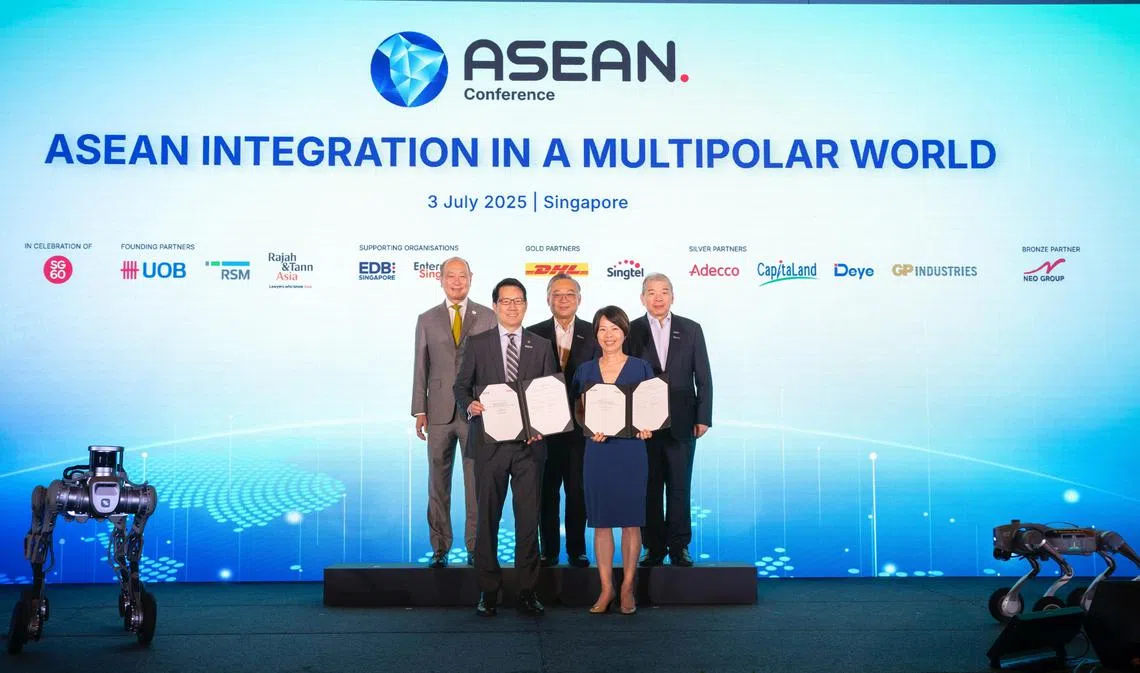Ripe time to grow regional industrial giants, work towards Asean-led development: panellists
UOB inks five deals with government agencies and leading industry players across Asean and China at the Asean Conference

[SINGAPORE] In an era marked by multipolarity, supply chain disruptions, geopolitical conflicts and growing protectionism, it is a pivotal time to strive towards creating regional industrial champions and advancing Asean-led development to deepen intra-bloc integration.
Such sentiments were shared by panellists on Thursday (Jul 3) at the Asean Conference, during a ministerial dialogue titled “Asean integration in the multipolar world” with Singapore Deputy Prime Minister Gan Kim Yong.
The day-long event at the Resorts World Convention Centre was organised by the Singapore Business Federation (SBF), alongside founding partners UOB, RSM Singapore and Rajah & Tann.
The panel featured Malaysian Deputy Minister of Investment, Trade and Industry Liew Chin Tong, and Indonesian Deputy Minister for Investment Cooperation at the Ministry of Investment and Downstream Industry Tirta Nugraha Mursitama.
The hour-long session was moderated by SBF chief executive officer Kok Ping Soon, and explored how each country interprets the mandate of an integrated Asean and their plans to deliver on this.
Noting that now is a difficult but interesting time for Asean, Liew posed the question: “Do we still rely on a foreign direct investment-driven economic growth model or an export-led industrialisation model where we export to the US – or do we start thinking about growing Asean companies?”
The bloc has to start thinking about growing regional giants and creating its own technologies – with that, he said, intra-Asean cooperation, integration and trade will not be too difficult because member states will have to work with one another.
On the way forward, Prof Tirta said: “My optimistic way of thinking is that if we are internally strong as Asean... we can create the idea of not state-led development but Asean-led development.”
The Indonesian minister called for stronger cooperation and communication between business and government leaders.
Bilateral and regional complementarity
On recent news of Vietnam’s trade agreement with the US that supposedly culminated in a lower-than-promised 20 per cent levy, SBF’s Kok noted that the world’s largest economy is “obviously pursuing a divide-and-conquer strategy”.
On whether that weakens Asean centrality, DPM Gan, who is also minister for trade and industry, contended that, at the end of the day, tariffs have to be negotiated bilaterally.
Nonetheless, Asean member states have made a commitment to honour agreements signed with one another, so as to ensure intra-bloc trade remains rules-based, he continued.
“Even while we negotiate with the US separately and bilaterally, at the same time, at the back of our minds, we remain committed to Asean cooperation and integration,” he said.
His sentiments were echoed by SBF chairman Teo Siong Seng, who highlighted the importance of Asean’s collective response in his welcome remarks.
Known in the shipping circles as SS Teo, the executive chairman of home-grown carrier Pacific International Lines said: “At the enterprise level, many companies initially adopted a wait-and-see stance, viewing themselves as price takers or downstream in the supply chain, or assuming the tariffs were just a scare tactic.”
But it has become clear that action must be taken, he continued.
In an environment characterised by trade realignment and uncertainty around capital flows brought about by a shift in US trade policy, Teo noted: “Asean’s collective response will be crucial (and) we are already seeing our community step up.”
UOB deputy chairman and CEO Wee Ee Cheong highlighted in his opening address the opportunities from the rapidly expanding digital economy, and new investments in climate and sustainability.
Artificial intelligence and environmental, social and governance factors are now central to government and business trends, added Wee, who urged small and medium-sized enterprises to adapt their business models to compete and thrive.
“Let us all work together to build (an) inclusive Asean, where every business – big or small – has a stake in our shared success,” he said.
Deepening cooperation
The conference also saw UOB ink five memorandums of understanding with government agencies and leading industry players across Asean and China.
The agreement between the lender and Enterprise Singapore saw both parties pledging to encourage partnerships between local enterprises and foreign companies seeking to expand in the region.

A second deal, with the Federation of Malaysian Manufacturing and Singapore Manufacturing Federation, is aimed at facilitating business opportunities in the region.
The third pact was between UOB Hong Kong and the Hong Kong Trade Development Council, and is aimed at establishing a framework of cooperation to strengthen regional ties and promote sustainable growth.
The fourth agreement was signed by UOB China and ZGC International. It will see UOB China providing complementary financial services and empowering the cross-border development of companies in ZGC industrial parks.
The final memorandum, which was between UOB, J-Will Corporation and Hildrics Capital, is aimed at the joint development of business opportunities and supporting Japanese companies entering the Asean market.
Noting that the region remains an attractive destination for businesses despite global tensions, Wee said: “As opportunities arise from the rewiring of global supply chains, trade flows within Asean and between China and Asean are expected to increase.”
Decoding Asia newsletter: your guide to navigating Asia in a new global order. Sign up here to get Decoding Asia newsletter. Delivered to your inbox. Free.
Copyright SPH Media. All rights reserved.


